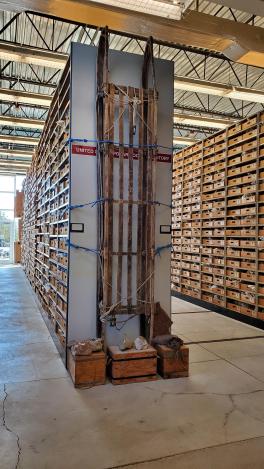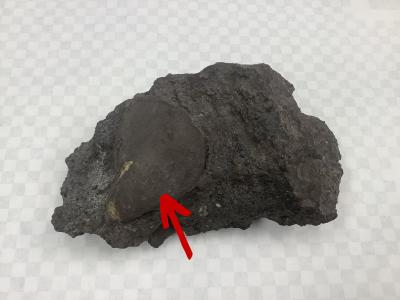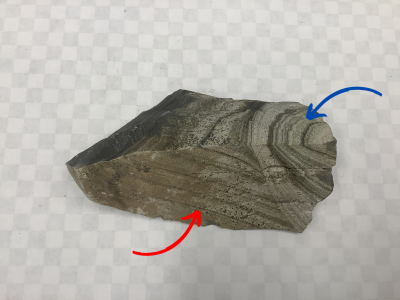Background
Brought to you by the Polar Rock Repository, these mystery geology questions are designed to test your knowledge of rocks and fossils, putting you in the shoes of a polar scientist. The PRR houses over 60,000 rock samples from Antarctica, South America, Africa, and the Southern Ocean, and is one of the largest collections of Antarctic rocks in the world. Samples can be loaned to researchers and educators, expanding the accessibility of polar geology. A selection of these samples were chosen in fall 2022 to create "Rocktober," a month of interactive rock-based trivia questions posted to social media. All of the samples and trivia questions from Rocktober are shown below.
You may interact with each sample below by clicking on it. Once you click on a sample, an option to maximize it to full screen will be available.
Answers to all questions are available at the bottom of the page. If you are using these challenges in a classroom, cut and paste the question text onto a separate document and give students a direct link to the sample that corresponds with it. Sample links are available by clicking the PRR number below the sample image.

a) What grain size do you see most in this rock? Based on that, what is the rock name?
Options: conglomerate (pebble), sandstone (sand), siltstone (silt), shale/claystone (clay)
The size of the grains in a rock can tell you about the type of environment it was deposited in. Rocks with large grains (pebbles/boulders) form in a high energy environments like a mountain stream or beach with really strong waves because smaller grains would get swept away. Rocks with extremely small grains (like clay) form in much calmer environments (like the deep ocean) because those grains are easily transported away.
b) Based on the grain size in this rock, what was the environment like when it formed?
Sample 2
This sample is a volcanic bomb from Southern Victoria Land, Antarctica.
a) Do you know when this rock solidified?
Options: A) before eruption B) during explosive eruption C) after eruption
b) How can you tell when this rock solidified?
Sample 3
Our third sample is a more popular type of rock, granite. Granite is formed over million of years from cooling magma. As the magma/lava cools, crystals begin to form. Crystal size can give us hints as to where igneous rocks formed because larger crystals take longer to form, meaning the magma/lava takes longer to cool.
a) Based on how large the crystals are, did this granite form at/near the surface or deep within the crust?
b) What is the name of the pink mineral we see here? What are some other minerals you would find in granite?
Sample 4
This sample is from the Carapace Nunatak, a "glacial island" in the Transantarctic Mountains.
a) What kind of organism did this come from?
Options: plant, animal, fungus, or trace fossil
This sample is from the Jurassic Era, 201-145 million years ago!
b) What does this fossil tell us about the environment in this part of Antarctica back then compared to now?
Sample 5
This sample is dunite, a major component of the Earth's mantle. Dunite is composed of over 90% olivine, which ranges from chartreuse to olive green.
a) What is olivine called in its gem form?
Options: Peridot, Jade, Aquamarine, or Emerald
Dunite is rarely found on land. However, dunite (and other mantle rocks) are large sources of chromium, garnet, and almost all natural diamonds!
b) How would dunite get to the Earth's surface? Where do you think we might find dunite on the Earth's surface?
Sample 6
This sample is Gneiss! Pronounced "nice," it is a metamorphic rock (a type of rock that has been physically/chemically changed by extreme heat and pressure) that forms deep within the Earth's crust.
a) What is the protolith, or parent rock, of this rock? (What type of rock was this before it was metamorphosed?)
Options: sandstone, granite, gabbro, or conglomerate?
Contact metamorphism occurs where minerals and texture of a rock are changed, mainly by heat, due to contact with magma. Regional metamorphism occurs where minerals and texture of a rock are changed by heat and pressure over a wide area (like during a mountain building event).
b) Which type of metamorphism did this rock go through?
c) Do you think the event that created the Transantarctic Mountains (where this rock was located) is the same event that metamorphosed this rock? Why or why not?
Sample 7
Basalt is an extremely common igneous rock that makes up many volcanic islands (like Hawaii), is found on the moon and Mars, and composes the majority of oceanic crust. Oceanic crust is continuously being created at midocean ridges, but generally doesn't last longer than 200 million years. In contrast, continental crust is often over 1 billion years old.
7. a) Why don't we see billion-year-old oceanic crust? What happens to it?

The arrow is pointing to a xenolith- a rock fragment trapped inside the basalt. Xenoliths are fragments torn loose from walls of a magma chamber or even picked up during a lava flow on the surface.
7. b) What type of rock is this xenolith? Did it come from deep within the Earth or was it picked up near the surface?
Sample 8
This rock from Peterson Hills, a group of hills in Antarctica, is another clastic sedimentary rock made of pre-existing rock pieces.
a) What grain size is most abundant? Based on grain size, what is the rock name?

The different non-parallel layers in this rock are known as crossbedding, which form from wind/water moving sand in different directions. Which layers were deposited first?
b) Which layers were deposited first?
Sample 9
The next samples are ammonites from Seymour Island on the Antarctic Peninsula. Ammonites are commonly used as index fossils, a fossil used for dating the rock in which it is found.
a) Which of these characteristics would NOT make a good index fossil: commonly found, wide distribution, limited time span, or large time span?
b) These Ammonites are from the Cretaceous period (145-66 million years ago). What can they tell us about what the environment was like in this part of Antarctica back then?
Sample 10
Mt. Erebus, the southernmost active volcano in the world, is well known for erupting strange rocks such as this, which is called Kenyte. Based on the name,
a) Where else do you think this rock has been found?
Kenytes have large plagioclase crystals (a type of mineral), but they are surrounded by a very fine grained/glassy matrix. However, we learned previously that crystals grow larger when magma cools slower.
b) How can we have such drastically different crystal sizes in the same rock?
Sample 11
Our next rock is an igneous sample known as Dolerite. This sample is from the Ferrar Large Igneous Province (LIP), one of the most prominent outcrops in Antarctica that is exposed for thousands of kilometers along the length of the Transantarctic Mountains.
a) Do you think it formed near/at Earth's surface or deep below the surface?
This rock is also a ventifact- a rock that has been etched/polished by wind-driven sand or ice crystals. Ventifacts have been found in many different places, including Mars!
b) What type of environment would you most commonly find these in?
Sample 12
We have seen this rock in a previous sample.
a) What type of rock is this?
Options: basalt, granite, dunite, sandstone, or gneiss?
Like the prior rock, this sample is also a ventifact.
b) Why would this rock be shaped so differently from the previous sample?
Sample 13
Hyaloclastites can occur in submarine (underwater) or subglacial (under ice) environments. Antarctica is the largest glaciovolcanic province in the world, spanning roughly 5,000km. The interaction between ice and lava is often violent and explosive.
a) Does this look like a rock that had an explosive beginning? How can you tell?
b) What is another place on Earth that we might get hyaloclastites besides Antarctica?
Answers
Sample 1: a) The dominant grain size is silt, making this rock siltstone. b) This suggests it was formed in a calm/low energy environment.
Sample 2: a) During explosive eruption b) the streamlined, raindrop shape and the small/no visible crystals suggests it solidified in midair, quickly freezing once erupted from the volcano
Sample 3: a) Large crystals suggest it formed deep in the crust. b) The pink mineral is feldspar (potassium feldspar/alkali feldspar/orthoclase/microcline); other minerals could include plagioclase, biotite, muscovite, quartz
Sample 4: a) fossil wood/tree b) This suggests Antarctica was once warmer and wetter, and covered in forests
Sample 5: a) Peridot b) Dunite gets to the surface via volcanism; areas with a lot of volcanism (bonus if you used the words; ophiolites/kimberlite pipes)
Sample 6: a) Granite. b) This rock went through REGIONAL metamorphism. c) NOT the same event - gneiss forms deep within crust but was found at the surface (time for erosion and other exhumation processes)
Sample 7: a) oceanic crust gets recycled at subduction zones, where two plate tectonics collide, one sliding beneath the other, this happens frequently and cycles the oceanic crust back into the mantle b) Dunite/peridotite xenolith - from the mantle (deep; NOT the near surface)
Sample 8: a) Sand, making this sandstone b) The truncated layers were deposited first, pointed out by the red arrow
Sample 9: a) A species that lived during a larger time span makes it much harder to use the fossil to narrow down the age of the rock b) Ammonites are from a marine environment so we know the area was underwater
Sample 10: a) Named for Mt. Kenya - 2nd highest African mountain after Kilimanjaro b) Different cooling times - plagioclase crystals grew in magma chamber, the rest cooled after being erupted
Sample 11: a) Dolerite formed near / at surface (fine grained) b) Arid / dry, strong winds, little vegetation, steady supply of sand. NOT temperature dependent
Sample 12: a) Granite b) It was etched by coarser grains, creating less sharp edges
Sample 13: a) Yes, it had an explosive beginning, you can tell by its fragmented appearance b) Iceland, Hawaii, midocean ridges (anywhere with volcanoes + water/ice)
